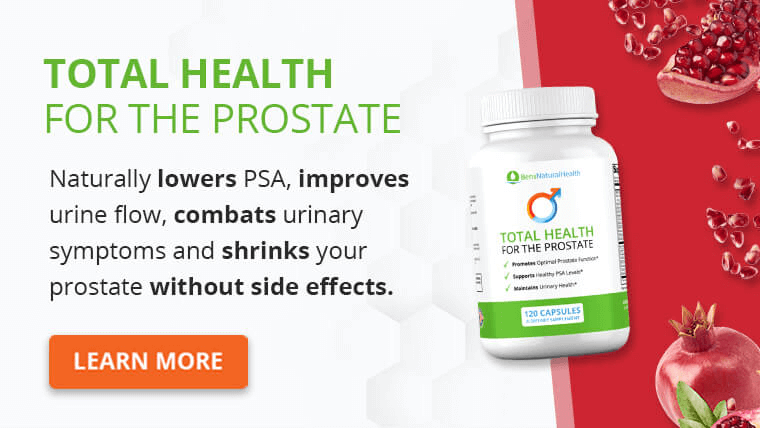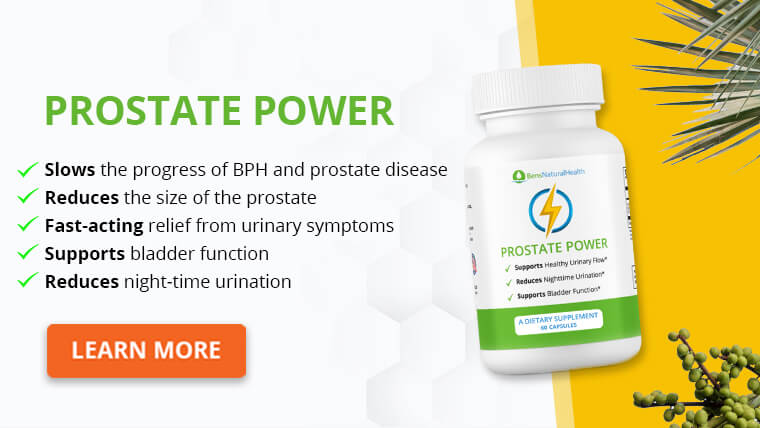The prostate is a small gland, about the size of a walnut, that sits in the pelvis region of the male body.
While the gland primarily performs a single action, it does play a major part in male reproductive health.
The prostate fluids that this gland produces serve as a type of nourishment for sperm.
Unfortunately, prostate problems are quite common among men.
Studies show that these problems become more apparent among older individuals, with up to 60% of men between 40 and 90 experiencing prostate symptoms (1).
There are several supplements that men can use to reduce the risk of prostate problems.
Some of these supplements may also provide an effective solution for reducing existing symptoms.
What Is Beta-Sitosterol?
Beta-sitosterol has become a very popular choice for men who experience problems with their prostate. In particular, researchers have found that beta-sitosterol is especially useful for men who have a condition known as benign prostatic hyperplasia, or BPH for short.
This particular condition causes the prostate gland to experience inflammation and enlarge. Thus, beta-sitosterol is often considered one of the best supplements for enlarged prostate.
Beta-sitosterol is classified as a plant sterol. Its structure is very similar to that of cholesterol.
There are several natural sources of beta-sitosterol. Seeds, nuts, vegetables, and fruit are just some examples of ways that people can increase their intake of beta-sitosterol.
Uses for beta-sitosterol
There are two major uses for supplements that contain beta-sitosterol. Many individuals turn to these supplements or natural sources of sterol to help with cholesterol management.
Several studies back up these claims. In one study (2), researchers considered the effects of beta-sitosterol on cholesterol levels among 28 participants.
All of the study participants had signs of hypercholesterolemia by the starting phase. The researchers used a combination of phytosterols, including beta-sitosterol, as a treatment option. A 12-gram daily dose was administered to each patient.
By the end of the study, there was a significant reduction in total cholesterol among the individuals taking the phytosterol. Additionally, researchers also noted a decrease in LDL cholesterol levels.
Apart from using the supplement for cholesterol, many men use it to help with their prostate. You can turn to beta-sitosterol to reduce existing symptoms or as a preventative strategy.
Multiple studies show the potential of beta-sitosterol when it comes to the prostate in particular.
One research paper (3) reviews the results from four previously conducted studies. Each study features a placebo-controlled structure with randomized groups. Among all studies, there were 519 men in total.
There are multiple improvements that the men in the study reported. This included an improvement in urinary flow.
Problems with the urinary flow are a relatively common complaint among men with benign prostatic hyperplasia. Additionally, other urinary symptoms also seem to improve with beta-sitosterol supplements.

What Is Saw Palmetto?
Saw palmetto is a type of tree that features leaves often associated with the shape of a fan. Each leaf features a thorn-like shape, and the tree can grow up to a length of around 10 feet. This is a fruit-bearing tree.
Once the fruit on the saw palmetto tree is ripe, then they are used in the production of certain natural medicines. This includes supplements that can help men with their prostate-related issues.
The main reason why some men take saw palmetto supplements are due to the beta-sitosterol content. We already discussed the potential uses of beta-sitosterol, which is why it makes sense to turn to saw palmetto.
The fruit of this tree does contain beta-sitosterol. It is important to note, though, that the concentration of beta-sitosterol in saw palmetto is much lower than a supplement that focuses solely on this particular plant sterol.
Thus, the effectiveness of a saw palmetto supplement may feel less potent when you compare it to a beta-sitosterol supplement.
With this said, some men also turn to saw palmetto for other reasons. Some sources suggest that saw palmetto could possibly provide an efficient solution for people who experience hair loss.
Note that this only accounts for some forms of hair loss. The compounds in saw palmetto may also provide a solution to reduce the amount of testosterone the body converts into another hormone, known as dihydrotestosterone.

Similarities And Differences Between Beta-Sitosterol vs Saw Palmetto
When you look at prostate supplements, two common main ingredients include beta-sitosterol and saw palmetto.
Both of these are sometimes listed among the best-enlarged prostate supplements. There are similarities between the two supplements. When you are looking for the best health supplement, you need to have a good understanding of the differences too.
The major similarity when comparing saw palmetto vs beta-sitosterol is the plant sterol. Beta-sitosterol is actually the main plant sterol that comes to mind when looking at this type of prostate care supplement. Saw palmetto contains some beta-sitosterol but also comes with additional plant-based compounds.
The primary difference here is the potency. When you want natural supplements for prostate health that are more potent, then opting for a formula that primarily uses beta-sitosterol is usually the better choice.
It is also important to note that beta-sitosterol is not the only sterol you get in a supplement that uses saw palmetto for BPH. Saw palmetto oil or capsules contain additional sterols that contribute to the specific benefits that people associate with this option.
These sterols consist of:
- Campesterol
- Beta sitosterol
- Stigmasterol
- Cholesterol
- Brassicasterol
This is why you may sometimes find questions like, does saw palmetto increase testosterone? The combination of sterols could potentially help to limit the conversion of testosterone to dihydrotestosterone. This leaves more testosterone circulating through the man’s blood circulatory system.
Beta-Sitosterol vs Saw Palmetto Effectiveness
Now that we have considered the differences and similarities, we should now look at how effective each of these is. It is important to note that the effectiveness differs based on what you want to use the supplement for.
Thus, to determine what you should expect, make sure you know why you want to use a prostate support product. Improving your prostate with saw palmetto, for example, may limit the results you achieve compared to beta-sitosterol.
If you want a more potent effect of beta-sitosterol in particular, then opt for a supplement that uses this as the primary ingredient. This is often found in natural prostate supplements.
Saw palmetto also makes an appearance in many enlarged prostate supplements. You may notice a more significant decrease in prostate and urinary symptoms when taking a beta-sitosterol supplement.
When it comes to looking at beta sitosterol for hair loss, however, saw palmetto is sometimes viewed as the better choice. This is because saw palmetto contains ingredients that may help to reduce testosterone conversion.
Some studies have shown a link between dihydrotestosterone and hair loss (4). By limiting the conversion, there is less of this hormone circulating in the body. Thus, the saw palmetto supplement could prove useful.
If prostate issues are causing problems with the male reproductive system, then some people may ask about using beta-sitosterol for erectile dysfunction. The effectiveness depends on why the person experiences erectile dysfunction.
If the prostate directly contributes to these symptoms, then the supplement can be helpful. However, when testosterone is causing problems, it is a good idea to consider the relation between saw palmetto and testosterone.
Get Your FREE PSA Lowering Diet Plan!
- Naturally lower PSA levels
- Reduce nighttime trips to the bathroom
- Enjoy better bladder control and urine flow
How Long Does It Take Beta-Sitosterol vs Saw Palmetto To Work?
Conventional medical treatments tend to work relatively quickly. The same is not true even for the best natural prostate supplements.
When you turn to supplements that use natural ingredients, it is important to note that you have to give it some time to start working.
There is no fixed time span for when you will notice differences. It generally differs from one person to the next when using prostate supplements that work. You should also ensure you take the appropriate dose daily.
In most cases, men who use some of the best beta-sitosterol supplements report noticeable improvements within the first three to six months. Due to the low beta-sitosterol content in the alternative, saw palmetto results may take somewhat longer.
Can I Take Beta-Sitosterol And Saw Palmetto Together?
Many supplements to increase urine flow and improve other prostate symptoms in men use a combination of different ingredients in their formula.
You may also find that some of these options use both saw palmetto and beta-sitosterol. This brings up the question – can you use beta-sitosterol and saw palmetto in one supplement?
The saw palmetto oil extract in the supplement will contribute to the beta-sitosterol content. This means the supplement will give you a bit more of the plant sterol than what is listed as “beta-sitosterol.”
It also means that the BPH natural supplements may provide additional benefits, such as helping prevent hair loss, serving as a protector for your prostate, and reducing dihydrotestosterone.
Get your FREE bladder diary
- Daily bladder diary
- Better understand your urinary symptoms
- Step-by-step guide
Conclusion
Both beta-sitosterol and saw palmetto are common supplements on the market for prostate health. Beta-sitosterol has a significant amount of research that backs up its potential benefits. It is also a compound that you can find in saw palmetto, although the concentration may be too low to produce noticeable benefits.
This is why many people may prefer using a beta-sitosterol supplement due to the higher concentration of this cholesterol-like substance. The supplement can provide a beneficial choice for men over 40 who want to protect their prostate and may also yield additional health benefits.
Explore More








